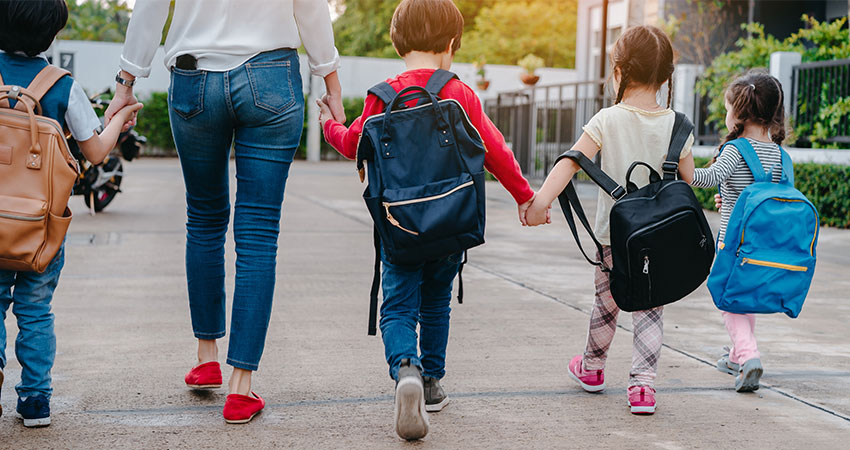The uncertainty around schools reopening has made this back to school season unlike any before it for retailers, with school supplies lists often unknown as districts work out details, and the normal cadence of discount events and promotions disrupted as well, experts say.
Apparel sales have been hit hardest, with plenty of off-price activity as inventory has shifted there and economic concerns drive bargain hunting, while sales of computers and devices to power home classrooms remain strong as was the case when the shutdowns first occurred last spring.
Darren Morrison, a managing director at Berkeley Research Group, said back-to-school demand has been dampened compared to past years when all sales channels have been fully open and engaged, and with parents a bit gun shy on spending as local district details get worked out.
“While there’s an uptick in ecommerce demand, it’s still a bit muted compared to when all channels are open,” Morrison said. “There’s also hesitation on the part of consumers, waiting for more clarification, and trying to time the sales opportunities. Those are two pretty important trends we’re seeing.”
Even with all the uncertainty, the National Retail Federation is in the back-to-school cheering section. The NRF, along with Prosper Insights & Analytics, is calling for total spend to increase 26.2% to a record $33.9 billion, up from $26.2 billion in 2019. Much of that is driven by planned technology spend, with apparel down slightly, NRF predicted.
Average per-family back-to-school spending for elementary through high school is also projected to hit a record $789.49, the NRF said, topping last year’s high mark of $696.70 by 13.3%.
By contrast, Deloitte is more pessimistic, projecting a flat 2020 at $28.1 billion for K-12 spending, averaging about $529 per student, with apparel dropping by 17% and accessories by 18%. Technology spending, projected to increase 28%, saves the season from a loss, Deloitte said. Retail consultancy GlobalData is going further, calling for a 6.4% drop in elementary through high school spending to $26.4 billion and a larger drop – 37.8% – in college spending.
Ronen Lazar, co-founder and CEO of Inturn, a provider of excess inventory solutions, said back to school is a microcosm of what’s happening in retail in general.
“A lot of consumers have pulled back spending,” Lazar said. “Ultimately, people are shopping but it’s typically deep discount opportunities. Conversely, brands have so much inventory, and they’re recognizing the discounted nature of the market that’s been in existence for years, but is more pronounced in this environment. It’s a real struggle enticing and reaching consumers.”
The main barometer is how COVID-19 rates behave into the fall, Lazar said, echoing many others. “The challenge at this point, with all the spikes going on different states and numbers starting to creep back up, what that will do to the equation, not only for schools but general consumer habits,” he said.
In fact, John Fleming, interim CEO of apparel chain rue21, told the Associated Press that the company’s sales figures look like “a COVID-19 map,” with stores in spiking states experiencing a sales drop, while they are increasing in the Northeast, where infections are down or flat.
Alex Czurylo, senior vice president of group product operations at Rakuten Advertising, said its polling of consumers found 50% of them plan to spend less $500 on back to school for elementary through high school, mainly due to the impact of high unemployment coupled with the uncertainty around on site education.
Rakuten Advertising also found 85% of consumers plan to do some of their back to school shopping online, up from 55% during the 2019 holiday season. “We’re also seeing a trend of people combining it with holiday shopping, browsing at the same time,” Czurylo said. “This early, people are thinking holiday deals, and retailers are trying to recoup first half sales losses by coming in with strong offers.”
Richard Maicki, also a managing director at Berkeley, said offering a range of flexible fulfillment options for shoppers is key to back to school success, as it has been throughout the pandemic, with a continuum of concern over increased infections. Also, he said, retailers need to double down on customer loyalty.
“Offer them a unique opportunity for being in the store through promotions, and protect your core customer,” he said. “It will help during the pandemic period and into the future. Trying times are a great opportunity to build relationships for the long term.”
Some other back to school stats:
- Community intelligence marketing platform AspireIQ found 79% of consumers said they are influenced by others when making back-to-school purchases, including personal recommendations (53%) and social media influencers (26%).
- Printify, which provides print-on-demand services for online sellers, said hoodies were its biggest winner this back-to-school season, with orders up 521% from 2019, and t-shirts are up 304%. Reflecting the broader supplies trend, backpacks were down 2%.

